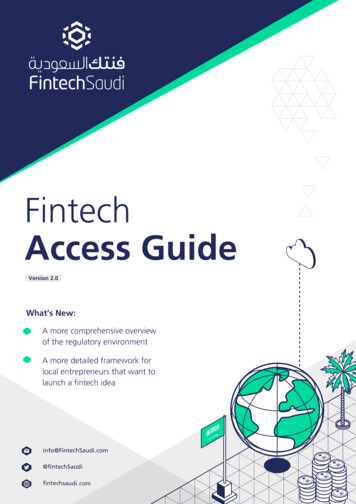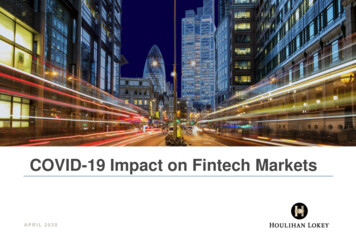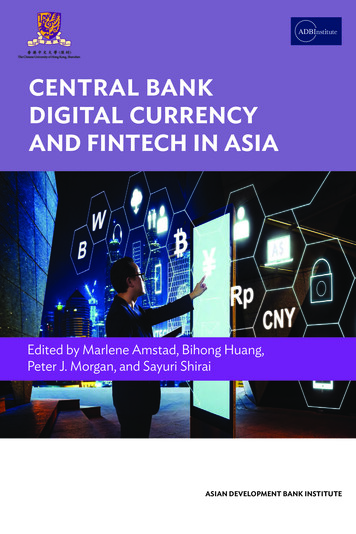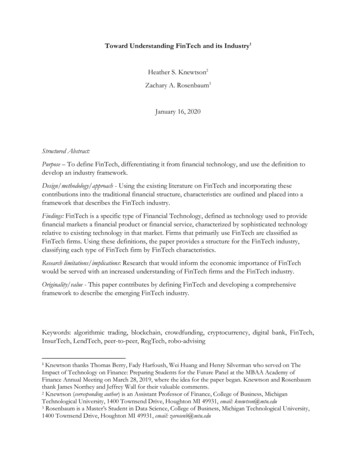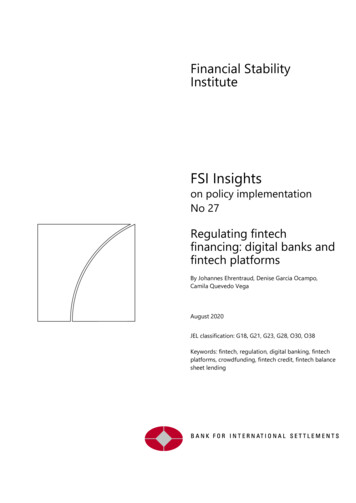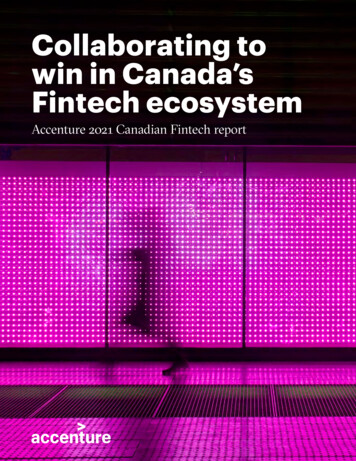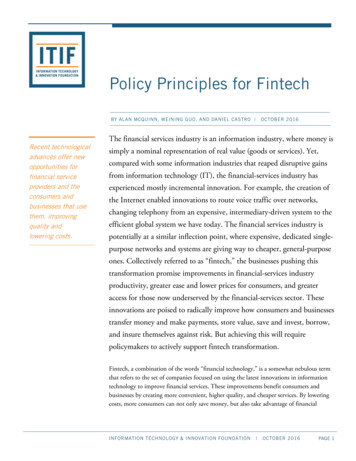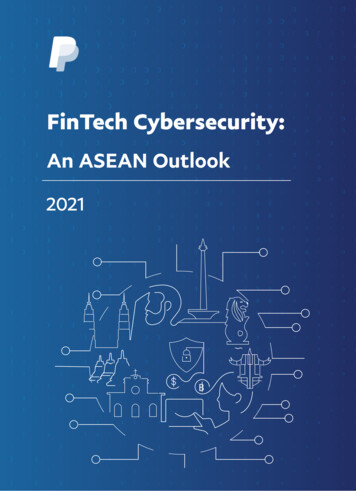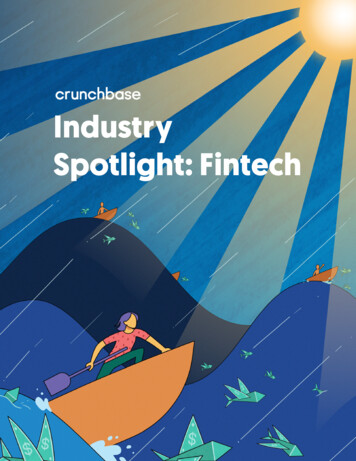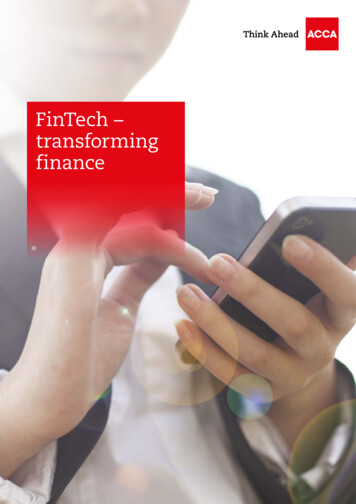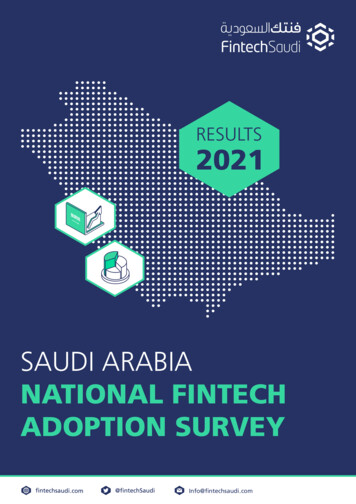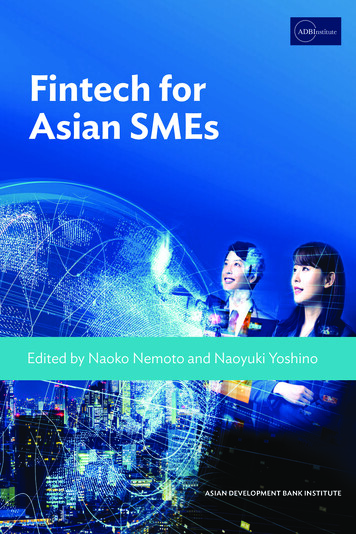
Transcription
Fintech forAsian SMEsEdited by Naoko Nemoto and Naoyuki YoshinoASIAN DEVELOPMENT BANK INSTITUTE
Fintech forAsian SMEsASIAN DEVELOPMENT BANK INSTITUTE
2019 Asian Development Bank InstituteAll rights reserved. First printed in 2019.ISBN 978-4-89974-109-1 (Print)ISBN 978-4-89974-110-7 (PDF)The views in this publication do not necessarily reflect the views and policies of theAsian Development Bank Institute (ADBI), its Advisory Council, ADB’s Board orGovernors, or the governments of ADB members.ADBI does not guarantee the accuracy of the data included in this publication andaccepts no responsibility for any consequence of their use. ADBI uses proper ADBmember names and abbreviations throughout and any variation or inaccuracy,including in citations and references, should be read as referring to the correct name.By making any designation of or reference to a particular territory or geographicarea, or by using the term “recognize,” “country,” or other geographical names in thispublication, ADBI does not intend to make any judgments as to the legal or otherstatus of any territory or area.Users are restricted from reselling, redistributing, or creating derivative works withoutthe express, written consent of ADBI.ADB recognizes “China” as the People’s Republic of China.Note: In this publication, “ ” refers to US dollars.Asian Development Bank InstituteKasumigaseki Building 8F3-2-5, Kasumigaseki, Chiyoda-kuTokyo 100-6008, Japanwww.adbi.org
ContentsTables, Figures, and Boxes viMessage from Surapol Opasatien xAbbreviations xiPreface xv1 How Digital Innovation Can Increase Small Business Access to Finance in Asia1by Sean Creehan1.1Asia’s SME Credit Gap Is Particularly Large 1.2 Asia’s Digitizing Economy: Can Leveraging Technology Fill the Gap?1.3 A Potential Structural Shift in the Economic Impact of Asia’s SMEs2 How Open Banking Can Support Finance for SMEs 131418by Julien Mahuzier2.1Executive Summary 182.2Open Banking 182.3 Open Banking for SMEs 222.4What Is to Be Done? 252.5Conclusion 283 Application of Distributed Ledger Technologies to Improve Funding in the Startup Ecosystem30by Naoyuki Yoshino and Farhad Taghizadeh-Hesary3.1Introduction 303.2Literature Review 333.3 Ecosystem of Startups Based on Distributed Ledger Technology 393.4Model 443.5Concluding Remarks 50iii
ivContents4 Credit Risk Reduction Effect on SME Finance through the Use of Bank Account Information55 by Naoko Nemoto, Naoyuki Yoshino, Yutaka Ohkubo,Daimei Inaba, and Kentaro Yanagisawa4.1Introduction 554.2Literature Review 594.3Theoretical Background 614.4Analysis of the SME Credit Risk Model 634.5Verification of the Credit Risk Model 794.6Conclusions 825 Role of the Credit Risk Database in Japan: Creation of New Economic Activity IndicatorsThrough Dynamic Monitoring of Bank Accounts87by Yutaka OhkuboCreation of New Economic Activity Indicators through Dynamic Monitoring of Bank Accounts916 Optimal Regulation of Peer-to-Peer Lending for SMEs104by Naoko Nemoto, David Storey, and Bihong Huang6.1Global Trend of Peer-to-Peer Lending 1046.2Peer-to-Peer Lending in the United States 1096.3Peer-to-Peer Lending in the United Kingdom 1106.4 Peer-to-Peer Lending in the People’s Republic of China 1126.5 Peer-to-Peer Lending in Japan 1156.6 Comparisons Across Countries 1176.7118Conclusions
vContents7 The Survival of SMEs in Thailand— New Challenges Posed by the Digital Economyand Financial Constraints121by Suppaleuk Sarpphaitoon7.1Introduction 1217.2 SMEs in Thailand: The Backbone of Economic Growth, Government Policy, and Economic Challenges1227.3Data and the Panel Regression Models 1337.4Results and Discussion 1387.5Concluding Remarks 1438 The Role of Digital Payments Fintech in Accelerating the Developmentof MSMEs in Indonesia145by Nika Pranata8.1Introduction 1458.2Literature Review 1478.3 Research Location, Data, and Respondents’ Characteristics1488.4153Methodology 8.5 Digital Payments Fintech and Its Role in Accelerating the Development of MSMEs 1538.6Conclusions 1638.7Policy Recommendations 1649 A Proposal on the “i Bank Index”: A Measure of Banks’ Ability to Nurture Client Businesses167by Kiyotsugu Yoshihara9.1Research Objectives 1679.2Explanation of the New Index 1699.3What Exactly Does the New Index Measure? 1719.4 Modeling the New Index 1749.5 Summary: Uses of the New Evaluating Indicator 176Index 178
Tables, Figures, and BoxesTABLES1.1Small Businesses Play a Large Role in Asian Economies 21.2Small Businesses’ Contribution to Exports in Select Economies 73.1Return Risk Trade-Off for Households’ Investments 454.1List of Financial Indicators 664.2Default Frequency Data 694.3Comparison of Sales for the In-Sample and Out-Sample Data 694.4 Results of Principal Component Analysis: Financial Information (Balance Sheets and Financial Statements)714.5 Results of Principal Component Analysis: Bank Account Information 724.6734.7 Results of Estimates: Financial Model (Balance Sheets and Financial Statements) 764.8Results of Estimates: Bank Account Model 774.9Results of Hybrid Model 784.10 Accuracy Ratios of the In-Sample Data 794.11 Accuracy Ratios of the Out-Sample Data 794.12 Accuracy Ratios of the Total Data 804.13 Pearson Correlations: In-Sample Data 814.14 Pearson Correlations: Out-Sample Data 814.15 Pearson Correlations: Total 826.1viResults of Principal Component Analysis: Hybrid Peer-to-Peer Lending to Business, 2016 1056.2 Comparative Practices and Regulatory Regimes of Peer-to-Peer Lending1086.3118Peer-to-Peer Regulatory Comparisons
viiTables, Figures, and Boxes7.1 Quarterly Data of Thailand’s Gross Domestic Product for Selected Years 1237.2 Total Number of Employed Persons Classified by Types of Business, 2013–2016 1247.3Definition of SMEs in Thailand 1277.4Tax Schedule for Eligible SMEs 1287.5Number and Growth of Enterprises, 2013–2016 1287.6Internet, Broadband, Mobile, and Fixed-Line Subscriptions 1317.7Internet Activities in Thailand, 2017 1327.8Industry Classification 1347.9Data Descriptions 1367.10 Panel Regression Results for Small Enterprises 1398.1Types of Digital Payments Systems 1499.1Simple Deviation from the National Average 1729.2Comparison of Banks’ Picking Ability over a Long Time Frame 1739.3Comparison of a Bank’s Nurturing Ability over a Long Time Frame 173FIGURES1.1Typical Information Exchanges in Trade Finance Transactions 91.2Broadening Invoice Finance 142.1Different Types of Application Programming Interface Use 202.2 Example of a Mobile Banking Interface Aggregating Information from Several Financial Service Providers223.1 Unicorns Born in the United States, the People’s Republic of China, and the Rest of the World, 2013–2017 313.2 Improving the Startup Ecosystem Using Distributed Ledger Technology413.3 Utility Functions with Regard to Different Risk Preferences 473.4 Changes in Households’ Investment Preferences by Improving the Ecosystem of Startup Businesses 49
viiiTables, Figures, and Boxes3.5 Increase in Rates of Return and Reduction of Risk from the Introduction of Distributed LedgerTechnology-Based Hometown Investment Trust Fundsand a Credit Risk Database for Startups504.168Distribution of Targeted Firm Sales A4.1 Sample Lorenz Curve 865.1Risk Data Bank of Japan, Limited 875.2RDB Corporate Default Rate 885.3Japan SME Credit Score by S&P Global Market Intelligence 895.4RDB’s Business Portfolio 905.5Necessity of “Bank Accounts Dynamic Monitoring” 925.6Dynamic Monitoring of Bank Accounts 935.7Dynamic Monitoring 955.8 Development of SMEs through Dynamic Monitoring of Bank Accounts 965.998Dynamic New Economic Indicators 5.10 Disasters in Japan (2016–2018) 995.11 Emergency Monitoring and Reconstruction Plan 1005.12 Restoration after the Kumamoto Earthquake 1015.13 Dynamic Economic Indicators (Individuals) 1025.14 Relativity Analysis (Mutual Complementation) 1036.1 Principles Against Which to Evaluate Peer-to-Peer Lending Regimes1076.2 Platform Numbers and Regulatory Landmarks in the People’s Republic of China1136.3 Volume of Peer-to-Peer Lending in the People’s Republic of China, 2013–2017, New Lending Amounts1146.4114Number of Defaulted Platforms by Month 8.1 Respondents’ Fintech Provider 1508.2Composition of Respondents’ Educational Level 1508.3Respondents’ Job Composition 1518.4Nearest Financial Providers 152
ixTables, Figures, and Boxes8.5Respondents’ Mobile Phone Type and Internet Access 1528.6Reasons to Join Digital Payments 1588.7Digital Payments Impact to Respondents’ Businesses 1598.8Payment Preference 1598.9Evaluation of Digital Payments Fintech Services 1608.10 Issues of Digital Payments Fintech Services 1618.11 Suggestion for Digital Payments Fintech 1628.12 Ownership of Other Digital Payments Account 1629.1Ability-to-Pick Paradigm 1719.2Ability-to-Nurture Paradigm 171BOXES1.1Enhancing Credit Guarantee Programs 61.2Automation Makes Lending to Small Firms Viable 101.3Blockchain Could Expand SMEs’ Collateral for Borrowing 12
Message fromSurapol OpasatienChief Executive OfficerNational Credit Bureau Co., Ltd., ThailandIn “How Digital Innovation Can Help Small and Medium-sized Enterprise (SME) Accessto Finance in Asia” Conference, 29 October 2018We are now in the digital era. Banks are making more non-face-to-face bankingtransactions. Ten or twenty years ago, we know that the organizations inthe business ecosystem were banks and/or lenders, consumers and/or small andmedium-sized enterprises (SMEs), e-commerce merchants, or credit reportingagencies; and the ecosystem was not complex. But today, the ecosystem is changing.There are more organizations involve in the ecosystem and information from socialmedia becomes more important. Lenders such as peer-to-peer (P2P) lenders canoffer loans to their customers without using data from credit bureaus; and everyprocess can be done easily and quickly through mobile devices.In Thailand, the Bank of Thailand (BOT) has supported P2P lenders as the BOT willannounce the guideline for startup companies who would like to build P2P lendingplatform. Nowadays, people create data everyday and everywhere in the form ofphysical data, transaction data, or location data. Technology companies or platformsthat would like to enter the financial service market, or we can call it TechFin company,will benefit from its extensive data.In the past, we used to say “no land, no loan” as we used collateral-based lending. Afterthe financial crisis in 1997, we have used risk-based lending. Information from creditbureaus was very important. However, some SMEs and MSMEs or startup companiescould not access loans through this lending schemes. So, the BOT announced thepolicy guideline that the borrowers’ risk derived from financial data, behavior, andsocial information or information-based lending should be the next step to solve thispain point of SMEs from now on.Last, some people used to say that “data are the new oil.” But today some people saydata are not the new oil anymore, it is the air. Therefore, we should learn, change, andutilize the data that we have to efficiently run businesses in this digital era.x
AbbreviationsADBAsian Development BankADBIAsian Development Bank InstituteAIArtificial IntelligenceAICAkaike Information CriterionAISPAccount Information Service ProviderAMLAnti-Money LaunderingAPIApplication Programming InterfaceARAccuracy RatioASEANAssociation of Southeast Asian NationsATMAutomated Teller MachineB2BBusiness-to-BusinessBAHTNETBank of Thailand Automated High-Value Transfer NetworkBICentral Bank of IndonesiaBPRBusiness Process Re-engineeringCBRCChina Banking Regulatory CommissionCBSCore Banking SystemCEOChief Executive OfficerCFTCombating the Financing of TerrorismCGCCredit Guarantee CorporationsCMACompetition and Markets Authority (UK)CRDSME Credit Risk Information DatabaseCRDCredit Risk DatabaseCRDSCredit Risk Database for StartupsDAGDirected Acyclic GraphDBDDepartment of Business DevelopmentDFADigital Field ApplicationDFSDigital Financial ServicesDIDynamic IndicatorsDLTDistributed Ledger Technologyxi
xiiAbbreviationsDOPADepartment of Provincial AdministrationEATEarning After TaxEBAEuropean Banking AuthorityEBITEarnings before Interest and TaxesEBITDAEarnings before Interest, Tax Depreciation, and AmmotizationE-commerceElectronic commerce or Internet commerceEDCElectronic Data CaptureELECTRE ELimination Et Choix Traduisant la REalité(ELimination and Choice Expressing REality)ELECTRE TRIELECTRE TreeETDAElectronic Transactions Development AgencyEUEuropean UnionFCAFinancial Conduct AuthorityFIFinancial InstitutionFintechFinancial TechnologyFSAFinancial Service AgencyFSPFinancial Service ProviderGDPGross Domestic ProductGNIGross National IncomeGVAGross Value AddedHITHometown Investment TrustIoTInternet of ThingsIPOInitial Public OfferingsISAIndividual Savings AccountsITDCIndonesia Tourism Development CooperationKYCKnow Your CustomerLGDLoss Given at DefaultLIPIIndonesian Institute of SciencesMETIThe Ministry of Economy, Trade and Industry (Japan)MICTMinistry of Information and Communication TechnologyMIS Management Information System(CBS and other integrated systems)MNOMobile Network Operator
AbbreviationsmPOSmobile Point of SalesMRIMagnetic Resonance ImagingMSMEMicro, Small, and Medium EntrepreneurMSMEMicro, Small, and Medium EnterprisesNBTCNational Broadcasting and Telecommunications CommissionNPLOn-Performing LoanNPMNet Profit MarginNTBNusa Tenggara Barat (province of Indonesia)OECDOrganization for Economic Cooperation and DevelopmentOJKIndonesia Financial Services AuthorityOLSOrdinary Least SquaresOSMEPOffice of SMEs PromotionOTPOne Time ProtectionOTPOne Time PasswordP2PPeer-to-PeerPADGRegulation of the Board of GovernorsPBOCPeople’s Bank of ChinaPCPersonal ComputerPCAPrincipal Component AnalysisPDProbability of DefaultPDCAPlan Do Check Act or Plan Do Check AdjustPFIPreferred InfrastructurePKH Program Keluarga Harapan(Indonesian conditional cash transfer program)POSPoint of SalePRCPeople’s Republic of ChinaPSD2Payment Service Directive RevisedPSPPayment Service ProviderQR codeQuick Response codeRDRevenue DepartmentRDBRisk Data Bank of Japan, LimitedRTGSReal-Time Gross Settlementxiii
xivAbbreviationsSECSecurities and Exchange CommissionSFISpecialized Financial InstitutionSLAService Level AgreementSMAAStochastic Multicriteria Acceptability AnalysisSMESmall and Medium-sized EnterpriseSMESSSmall Medium Enterprise Sale SystemSMSShort Message ServiceTCGThai Credit Guarantee CorporationTekFinTeknologi Finansial (Indonesian)USUnited StatesUSSDUnstructured Supplementary Service DataVASValue-Added ServicesVCVenture CapitalYTDYear to Date
PrefaceSmall and medium-sized enterprises (SMEs) play a vital role as a driving force ineconomies around the world, especially in developing and emerging markets.SMEs in the Association of Southeast Asian Nations (ASEAN) region are estimatedto comprise more than 98% of the total number of enterprises, and they contributeto around 40% of gross domestic product. In order to enhance productivity andensure sustainable growth in Asia, providing smooth financing for SMEs is of criticalimportance.While loan volumes to individual SMEs are relatively small, SMEs tend to have lessdisclosed information. Therefore, traditionally, commercial banks have regardedloans to SMEs as risky, and they have tended to offer higher interest rates becauseof the lack of sufficient collateral due to SMEs’ limited liquidity. However, newtechnologies, including distributed ledger technology, cloud computing, and artificialintelligence, have started to enable faster, more convenient, and most cost-effectivefinancial services. The digital innovation is paving the way for SMEs to have access tobetter financial services.Accumulated digital data can complement the limited data disclosed by SMEs andreduce the cost of information asymmetries. In 2014, the National Credit Bureau(NCB) and I started analyzing banks’ lending records in Thailand to propose a newcredit rating scheme. The project aimed to contribute to filling the vast credit gaps inSME lending through the effective use of the NCB’s limited but reliable data on SMEs.Subsequently, rapid technological developments dramatically increased the availabledata sources and now provide various parties with the opportunities to leverage thedata in their activities. For instance, the Secretary of Finance in the Philippines plansto leverage satellite data to estimate underreported SMEs’ revenue and collect taxfairly. As an example, any underreporting of income by family-run restaurants can bereadily detected by using satellite data on visitors together with the average spendingper customer. The sales of smallholder farmers can also be reasonably estimated bymonitoring the growth of crops and the number of trucks entering and leaving fields.Furthermore, new technology and big data can also be employed to reduce thecost of information asymmetry between the financial sector and SMEs. Technologyadvancement improves the efficiency of financial institutions, including fintech firms,by encouraging competition, and it further enables SMEs to achieve more favorableterms for their financing.xv
xviPrefaceMeanwhile, growing opportunities are also encouraging governments and internationalsocieties to develop regulatory frameworks, especially for start-up businesses.Traditionally, the lending and monitoring criteria of financial institutions for SMEloans depended heavily on the judgements of experienced bankers. However, ampleand timely information made available by new technology and big data now allowinexperienced individuals to make investment decisions. Crowdfunding, peer-to-peer(P2P) lending, and other new tools can support start-up finance, but they carry uniqueand inherent risks. Investors are at risk of losing their invested funds, and SMEs relyingon such funding face the possibility of capital suddenly drying up or becoming moreexpensive in the future. Fraud, information leakages, and cyberattacks are additionalconcerns. The challenge for regulators is to protect investors and maintain financialstability while simultaneously maintaining an innovative market by harmonizing fairlaw enforcement, making appropriate interventions in the economy, and fosteringtechnology advancement. The development of a sensible regulatory framework iscrucial as the foundation of a vibrant and trustworthy business environment.The rapid development of fintech is increasing the need for financial education.Although fintech lowers the barriers to financing and investment, the fundamentalrisks and organizational limitations remain. Therefore, SMEs need to improve theirfinancial literacy to take the most advantage of the financial opportunities madepossible by fintech. Also, SMEs themselves can use fintech as a tool for analyzingtheir own businesses and improving performance. In this rapidly changing businessenvironment, SMEs are required to actively respond to transformation without gettingswept away by the trend.The purpose of this book is to identify and develop ideas on how to utilize newtechnology in SME finance. Effective utilization should encourage financial institutionsand investors to further develop credit risk analysis, increase financing, and contributeto the sustainable growth of SME sectors. Further, this book will explore ways in whichpolicymakers and market participants can maximize the benefits of and mitigate thepotential risks arising from the new digital era. The content of the book is based on theresearch presented at the conference, “How Digital Innovation Can Help Small andMedium-sized Enterprise (SME) Access to Finance in Asia,” organized by the AsianDevelopment Bank Institute and the NCB in October 2018.The first three chapters focus on the financial accessibility of SMEs using emergingfinancial technologies. Chapter 1 overviews the SME credit gap in Asia and assessesways for SMEs to improve their access to financial services. It further discussesthe ways to boost long-term economic growth using emerging technologies and
Prefaceinnovative business models. Chapter 2 discusses open banking and explains itsapplication in supporting SMEs. It introduces the key concept of open applicationprogramming interfaces and their role in connecting banking systems to a largerecosystem in comparison with traditional financial institutions. The chapter furtherdiscusses novel-use cases and examples and deliberates on the risks associated withopen banking. Chapter 3 sheds light on the practical solutions for filling the financinggap in risky businesses and start-ups. It discusses the application of distributedledger technologies for hometown investment trust fund schemes by incorporatingan information infrastructure, and a credit risk database for start-ups in order tocreate a more sustainable regional fund management framework by increasing theattractiveness for investors.Chapters 4 and 5 propose ways to harness the data generated by bank accounts toreduce time and costs for the realization of more efficient SME finance. Chapter 4introduces new dynamic monitoring indicators based on the information generatedby bank accounts and illustrates the benefits of timely and structural credit riskprofiling. It also provides an application of the indicators for the planning andimplementation of sound economic restoration from the damages caused bywide-ranging disasters. Chapter 5 discusses the potential of the utilization of bankaccount information based on empirical analyses of Japanese data. The analysesdemonstrate that the accuracy of default predictions improves, especially for SMEs,when the model incorporates bank account information in addition to traditionalfinancial information.In addition to the traditional lending by commercial banks, Chapter 6 describesand evaluates P2P lending for SMEs in various countries considering their differentsystems and regulatory regimes. More specifically, it carefully reviews the latestregulatory frameworks of the United States, the United Kingdom, the People’sRepublic of China, and Japan. It also suggests an effective regulation model for therisk management of loans.Chapters 7 and 8 examine the impact of fintech on SMEs in Asian countries.Chapter 7 presents an empirical study conducted for a broad range of industries inThailand. The study claims that the internet and mobile banking provide substantialsupport for SMEs in improving their business performance and increase thelikelihood of them continuing their business. Chapter 8 shows that even in cashdominant regions in Indonesia, the introduction of digital payments is beneficial forthe development of SMEs.xvii
xviiiPrefaceChapter 9 focuses on bank evaluation and introduces an index to measure banks’capability to nurture and develop corporate clients. In particular, the indicatorassesses the value of consultations and support provided by banks to client firmsregarding restructuring or enhancing of their performance drawing from businessrelationships fostered over time.I hope that this book will contribute to achieving stable, affordable, and long-termfinancing for SMEs in the Asian region as well as increasing the management capabilityof financial information security for financial service providers and other parties.Yoshino NaoyukiDean, Asian Development Bank Institute
ChapterHow Digital InnovationCan Increase Small BusinessAccess to Finance in Asia1Sean CreehanFederal Reserve Bank of San Francisco*Small and medium-sized enterprises (SMEs) are a key contributor to economicactivity around the world as an important source of jobs, growth, and innovation.1Despite their essential role, SMEs receive a disproportionately small share of creditfrom the financial system, a trend that persists across developed and developingcountries, including in Asia (ADB 2015a). This chapter summarizes the SME creditgap in Asia and assesses ways emerging technologies and innovative businessmodels—commonly known as “fintech”2—can improve SME access to financialservices in Asia and boost long-term economic growth in the process.1.1 Asia’s SME Credit Gap Is Particularly LargeSMEs are crucial to Asia’s economic vitality. They represent 42% of Asia’s grossdomestic product and are responsible for well over half of all jobs (see Table 1.1).3In addition, research on SMEs highlights their important role in innovation, with asignificant minority of highly innovative firms matching the profile of start-upstypically associated with places like Silicon Valley. Despite their important role, asignificant mismatch exists between SMEs’ economic impact and their access to*123The views expressed in this chapter are those of the author and do not necessarily represent theviews of the Federal Reserve Bank of San Francisco. Copyright 2018 Federal Reserve Bank ofSan Francisco. All rights reserved.The definition of small and medium-sized enterprises (SMEs) varies by country and according toindicators like head count or key financials. It typically applies to firms of 200–250 employees orfewer across developed and developing countries. In developing Asia, firms of asset sizes roughly 5 million and below are typically considered SMEs, though this can also vary by industry type.Revenue-based definitions tend to vary more widely by country, as firms with revenues exceeding 50 million might still be considered SMEs in the People’s Republic of China, while the threshold isbelow 5 million in countries like Indonesia or Viet Nam. See Vandenberg, Chantapacdepong, andYoshino (2016).This chapter defines “fintech” broadly as the use of new technology or innovative business models inthe delivery of financial services by both traditional, regulated firms and emerging start-ups.2014 estimate (ADB 2015b).1
2Fintech for Asian SMEsfinance—Asian SMEs receive just 18.7% of total bank credit.4 With nearly 1 millionnew jobs needed each month to absorb Asia’s growing workforce, expanding accessto credit for SMEs is a pressing policy priority (World Bank 2012).Table 1.1: Small Businesses Play a Large Role in Asian EconomiesSME Share ofEmployment (%)SME Contributionto GDP (%)Data YearChina, People’s Republic of64.760.02011, 2013Hong Kong, China47.0–India40.037.52015, 2013Indonesia97.060.32009, 2013Japan69.743.72012Korea, Republic 5.72013, hailand80.339.62014Viet Nam46.840.02012, 2011Economy2012GDP gross domestic product, SMEs small and medium-sized enterprises.Sources: Shinozaki (2012), APEC Policy Support Unit (2013), Yoshino and Wignaraja (2015).A joint study by the Organisation for Economic Co-operation and Development(OECD) and the Asian Development Bank (ADB) found that SMEs in Asia lag behindglobal peers in access to financial services, specifically credit. Notably, Asian SMEsare less likely than global peers to have made recent investments, and more likely tohave relied on retained earnings over external financing if they did so. The directionof causality between Asian SMEs’ investment and borrowing behavior is not easilydetermined, but Asian SMEs are roughly half as likely to apply for loans as globalpeers according to OECD–ADB surveys.5 Their reluctance to borrow may be due tostricter bank requirements: they are roughly 50% more likely to be required to providecollateral in borrowing.64562014 estimate.21.2% of Asian SMEs are likely to apply for a loan compared with 38.2% of their global peers(ADB 2014a).74.4% for Asian SMEs compared with 51.1% for global peers.
How Digital Innovation Can Increase Small Business Access to Finance in AsiaWhy the Credit Gap ExistsProviding financial services to SMEs generally involves greater costs and higher riskscompared with serving other types of enterprises. Small businesses have fewer assetsto use for collateral, less stable sources of revenue, and limited liquidity—factors thatincrease credit risk. From a cost perspective, providing a commercial loan involvessignificant operational costs prior to loan origination, such as customer acquisition,due diligence, regulatory compliance, credit risk analysis, and document processing.Loan servicing, particularly for higher-risk customers like SMEs, brings additionalcosts. Because SMEs typically borrow small amounts of money, lenders may findsuch loans less profitable, even if they charge higher interest to account for greatercredit risk. Instead, banks and other financial institutions generally rely on economiesof scale to lend efficiently, directing credit to larger customers.This problem is compounded by so-called “thin file” customers with limited to nocredit histories. By nature, many SMEs have never received funding from the formalfinancial system, either because of their early speculative stage (when they may relyon money from the entrepreneur’s savings or personal network) or limited collateralto back bank loans. Many developing countries lack robust credit rating systems andeven firms with some credit history may not qualify for loans. The limited availabilityof traditional data for credit risk assessment impacts banks’ lending decisions, drivinghigher interest rates for SMEs or limiting financing outright.1.2 A sia’s Digitizing Economy:Can Leveraging Technology Fill the Gap?Emerging financial technology and innovations in traditional business models cantake advantage of Asia’s rapidly digitizing economy to expand SMEs’ access to creditin Asia through several complementary improvements. The use of alternative datacan enhance credit analysis of small businesses previously disadvantaged by limitedcredit history, a problem in Asian countries without comprehensive credit bureaucoverage. Technology-driven changes to business models can also expand access tofinancial services with growth potential for Asia’s SMEs: trade finance, by modernizinginefficient processes and reducing the role of costly intermediaries, and
8.9 Evaluation of Digital Payments Fintech Services 160 8.10 Issues of Digital Payments Fintech Services 161 8.11 Suggestion for Digital Payments Fintech 162 8.12 Ownership of Other Digital Payments Account 162 9.1 Ability-to-Pick Paradigm 171 9.2 Ability-to-Nurture Par
